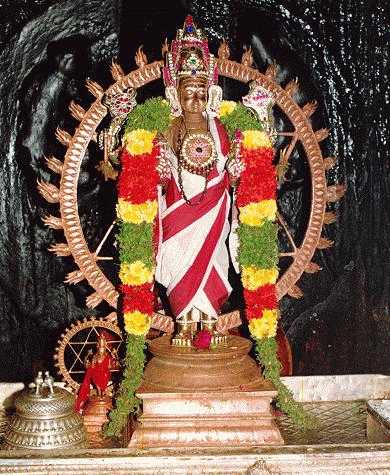GITA 8.20
We are at the sannidhi of Sri Chakrapani. Great Saints and Alwars have always praised the weapons of the Lord as in the famous verse pallandu, pallandu by Perialwar. The Lord graces always with the weapons held by Him. Firstly it guarantees protection to the devotees. During Utharayanam, that is six months starting from Tamil month thei [தை ] and next six months starting from Aadi (ஆடி), it is Dakshinayanam [indicating the transition of the Sun from South to North and North to South, as we see from earth]. In the garbagruha, the Lord is gracing with Eight arms, three eyes and raised hair on the head.
 |
| MOOLAVAR SRI CHAKRAPANI (in sketch) |
The feet are well pressed on the peetam. Near Him are Surya, sage Ahirbudhnya and god Agni are on one side. On the other side lord Brahma is gracing. All these prayed to pardon Surya and give back Surya's brilliance. In the right four arms, the Lord is holding the discus, a pestle, a goad and a lotus. In the left four arms are held conch, mace, noose and bow with arrow. The Lord's discus has Five parts. Rim with whirling fire is one part and is called jwala. Inner circumference is called nemi, is the second part. Third part is spokes joining rim centrenter called aram. Four- center with one side dented is aksham and raised is called kumbham. Five- the Central Force of the Lord is called Purusha. Our mind also is constantly revolving like the discus. Discus, though a weapon, also stands to decorate the Lord. Also Sudarsana identifies the Lord. Chanting the Panchayuda stotram in the morning will relieve us from all fears, sorrows and ills, and success will be achieved.
 |
| SRI SUDARSANA |
Now we will see 19th sloka. We saw that Universe gets created in Brahma's day time and gets destroyed and reaches the original 'raw' form during his night. This cycle continues endlessly. Sudarsanam is sowmyam darsanam - pleasing to look at. Su + darsanam means auspicious direction. He is also called as Nemi, Chakrarajan, Hetirajan, Rathangam, etc. Even 10 Million [koti] Suns' brilliance can not compare with Sudarsana's dazzling. In sloka 16, the Lord told the lifetime of Brahma. In sloka 17, He told that the Universe gets created in Brahma's daytime and destroyed in his night time. These get created from his body during creation and in the destruction they all become one with Brahma's body again and this was explained in sloka 18. Now, sloka 19:
bhuta-gramah sa evayam
bhutva bhutva praliyate
ratry-agame ’vasah partha
prabhavaty ahar-agame
bhutva bhutva praliyate
ratry-agame ’vasah partha
prabhavaty ahar-agame
"Again and again, when Brahma’s day arrives, all living entities come into being, and with the arrival of Brahma’s night they are helplessly annihilated because of karma."
Reading Arjuna's mind the Lord tries to clear a doubt in Arjuna - why should this cycle of creation and destruction happen? Can't the created ones remain for ever? Avasa = because all are bound by karma, they are born and die. Bhutha-grama = all living beings bound by karma, as an entity, avasa = bound by karma, bhutva = get created. By repeating this word it is implied that they get destroyed and re-created, again destroyed and again created, and so on. Praliyate = gets dissolved [to reach the original status], ratry-agame = in the night time [of Brahma]. We have the present body. Did we have birth before we were born? Will we have birth after death? Many may not believe in rebirths and past janma. Vedas, Itihasa and Purana, elaborately say that rebirths are there. For argument's sake, let us assume there was no birth for any of us earlier and after death there will be no rebirth. Many of us are enjoying or suffering, many for no reason in this birth. We see identical people having totally different experience in life. No tangible reasons could be found for this difference. We are living now is the effect. Then it means there should be a cause for the effect. It is common to see wicked people enjoying life and pious persons suffering. This finds explanation in the past birth's good or bad deeds. Similarly, there should be some effect for all our actions in this birth. If we do bad things then there should be punishment for that. Suppose in the midst of a very bad action, one dies suddenly, then should he escape punishment? So, only rebirths answer these questions. Thus, past births and rebirths are realities. If we do not agree on this, then we can not get answers for experiences in the current life nor will we ever do good things in this life. So, subject to karmas, all these three worlds - bhu, buva and suva - get created in Brahma's daytime and get dissolved in his night time. So any position in these worlds are never permanent and only the Lord's place is ever present. We will now move on to the next temple in Kumbakonam.
(continued)









